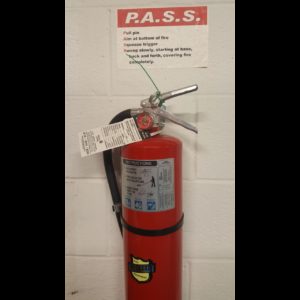This article is the third in a series to address the requirements of 40 CFR 265, Subpart D – Contingency Plan and Emergency Procedures as it applies to a large quantity generator of hazardous waste (LQG). Each article will explain the requirements of a specific section of Subpart D. Keep in mind the regulations of your state may differ from these Federal regulations.
The purpose of this article: identify and explain the requirements (some of them) of 40 CFR 265.52 Content of Contingency Plan.
Section 265.52 identifies the five required components of the contingency plan (paragraphs a, & c – f). An option to utilize the National Response Team’s Integrated Contingency Plan Guidance or “One Plan” is discussed in paragraph b of section 265.52. This article will explain the required content of the contingency plan (paragraphs a, & c – f) and leave the One Plan (paragraph b) to a later article.
Hold on a minute! These regulations were revised and moved to a new location within Title 40 of the CFR by the Generator Improvements Rule. If your state has not yet adopted the Generator Improvements Rule, then this article is still applicable to you (but it won’t be for much longer). If your state has adopted and been authorized to enforce the Generator Improvements Rule, then these regulations no longer apply to you. Read: What is the status of the Generator Improvements Rule in my state?
To see an explanation of these regulations as revised by the Generator Improvements Rule you must refer to the following:
Not sure of your hazardous waste generator category? |
To see an explanation of the regulations prior to the revisions of the Generator Improvements Rule, please continue reading this article.
§265.52 Contingency Plan and Emergency Procedures reads:
(a) The contingency plan must describe the actions facility personnel must take to comply with §§265.51 and 265.56 in response to fires, explosions, or any unplanned sudden or non-sudden release of hazardous waste or hazardous waste constituents to air, soil, or surface water at the facility.
(b) If the owner or operator has already prepared a Spill Prevention, Control, and Countermeasures (SPCC) Plan in accordance with Part 112 of this chapter, or some other emergency or contingency plan, he need only amend that plan to incorporate hazardous waste management provisions that are sufficient to comply with the requirements of this Part. The owner or operator may develop one contingency plan which meets all regulatory requirements. EPA recommends that the plan be based on the National Response Team’s Integrated Contingency Plan Guidance (“One Plan”). When modifications are made to non-RCRA provisions in an integrated contingency plan, the changes do not trigger the need for a RCRA permit modification.
(c) The plan must describe arrangements agreed to by local police departments, fire departments, hospitals, contractors, and State and local emergency response teams to coordinate emergency services, pursuant to §265.37.
(d) The plan must list names, addresses, and phone numbers (office and home) of all persons qualified to act as emergency coordinator (see §265.55), and this list must be kept up to date. Where more than one person is listed, one must be named as primary emergency coordinator and others must be listed in the order in which they will assume responsibility as alternates.
(e) The plan must include a list of all emergency equipment at the facility (such as fire extinguishing systems, spill control equipment, communications and alarm systems (internal and external), and decontamination equipment), where this equipment is required. This list must be kept up to date. In addition, the plan must include the location and a physical description of each item on the list, and a brief outline of its capabilities.
(f) The plan must include an evacuation plan for facility personnel where there is a possibility that evacuation could be necessary. This plan must describe signal(s) to be used to begin evacuation, evacuation routes, and alternate evacuation routes (in cases where the primary routes could be blocked by releases of hazardous waste or fires).
First of all, the contingency plan must describe emergency procedures that facility personnel must take to minimize the hazards arising from a fire, explosion or hazardous waste release. While the equipment and actions necessary to prevent and prepare for an emergency at a large quantity generator (LQG) or small quantity generator (SQG) are specified in §265, Subpart C, in the contingency plan an LQG must describe the specific actions their employees will take once the emergency has occurred or is imminent. There are eight emergency procedures defined at §265.56 (they will be addressed in detail in a later article), they are:
- Activation of internal alarms and notification of state or local agencies.
- Identify released materials.
- Assess hazards to health or environment caused by a release.
- Notification of a release to external parties.
- Ensure emergency does not spread or recur.
- Monitor stopped operations for pressure build-up.
- Immediately after emergency arrange for proper disposal of waste.
- Preparation of emergency equipment for resumption of activities and reporting of emergency to State and/or USEPA.
Interested in a Webinar that covers this topic, and more! |
Of course, these emergency procedures will be different for every facility depending on its characteristics and surroundings. Please take care to avoid merely reciting the text of §265.56, and instead take the time to specify the actions you will take to comply with the its requirements. You may wish to consider putting this information in a table or chart format, to include the following for each material:
- Its chemical or trade name.
- Amounts and locations.
- Physical and chemical properties.
- Its hazards and special precautions
- Emergency response actions, including identification of the absorbants, neutralizing agents, fire extinguishing agents, personal protective clothing, and any other appropriate materials and equipment that may be necessary.
 Secondly, the contingency plan must include a coordinated emergency services plan describing the arrangements agreed to by local police departments, fire departments, hospitals, contractors, and State and local emergency response teams. Here the regulations cite §265.37 Arrangements with local authorities which is included within 40 CFR 265, Subpart C Preparedness and Prevention. The difference between the requirements of Subpart C and Subpart D is that while the former only required a facility (LQGs and SQGs) to attempt arrangements with outside agencies, the latter requires the contingency plan to describe arrangements agreed to by those agencies. Merely stating that the authorities have received a copy of the contingency plan is insufficient. Options to document agreement include:
Secondly, the contingency plan must include a coordinated emergency services plan describing the arrangements agreed to by local police departments, fire departments, hospitals, contractors, and State and local emergency response teams. Here the regulations cite §265.37 Arrangements with local authorities which is included within 40 CFR 265, Subpart C Preparedness and Prevention. The difference between the requirements of Subpart C and Subpart D is that while the former only required a facility (LQGs and SQGs) to attempt arrangements with outside agencies, the latter requires the contingency plan to describe arrangements agreed to by those agencies. Merely stating that the authorities have received a copy of the contingency plan is insufficient. Options to document agreement include:
- Submit a copy of the contingency plan to specified authorities by certified mail Return Receipts with a cover letter indicating that they are your primary designated authority and you will expect them to respond to an emergency call from your facility unless they reply to your letter within a specified time frame (e.g., 10 business days).
- Submit a copy of the contingency plan to specified authorities by certified mail Return Receipts with a statement for the primary designated authority to sign and return to you stating their understanding of and agreement to your specified arrangements. It would be helpful to include a self-addressed stamped envelope with this submittal.
- Obtain a verbal commitment from the authorities indicating their agreement with your specified arrangements. Be sure to document this conversation.
Contact me with any questions you may have about the generation, identification, management, and disposal of hazardous waste Daniels Training Services, Inc. 815.821.1550 |
Thirdly, the plan must include a list of emergency coordinators who meet the qualifications of §265.55 Emergency coordinator (more on this in a later article). If more than one person is identified as an emergency coordinator, one must be named as the primary emergency coordinator and others must be listed as alternates in the order in which they will assume responsibility. The purpose of this list is to provide emergency responders with immediate access to persons who can provide information about the site, its operations, hazards, access, etc. To that end the contingency plan must include each emergency coordinator’s name, address (including home address), and phone number (office and home).
Next, the RCRA contingency plan must include a list of all emergency equipment at the facility, to include (where required):
- Fire extinguishing systems.
- Spill control equipment.
- Communications and alarm systems (internal and external).
- Decontamination equipment.
The plan must indicate the location of each item on the list along with a physical description, and a brief outline of its capabilities. Self-explanatory items such as shovels do not have to be described in detail. However, other items which have various sizes and capabilities must be described fully. This information may be complied in a table or chart format.
Finally, the plan must contain an evacuation plan if there is a possibility that evacuation could be necessary. The plan could be in the form of a site diagram or drawing, but must describe:
- Signals to be used to begin evacuation.
- Evacuation routes.
- Alternate evacuation routes in cases where the primary routes could be blocked by releases of hazardous waste or fires.
The consideration of alternate evacuation routes will require you to think beyond the standard “head for the exits” evacuation and instead think about how an emergency may impact your pre-determined evacuation routes and then to come up with alternates.
Is this all that is required to be included in a RCRA contingency plan? No, it is not. The remaining sections of Subpart D include additional information that will have to be included in the plan. These will be addressed in more detail in later articles of this series.
Next article in this series: The Requirements of 40 CFR 265.52(b) Content of the Contingency Plan. Options: The One Plan
Contact me the next time hazardous waste generator training is due to expire. |
If you are subject to the requirements of 40 CFR 265, Subpart D Contingency Plan and Emergency Procedures, then you must also provide initial and annual RCRA training for hazardous waste personnel.
